The disorder usually starts in the late teenage years, to early twenties. It is rather rare to see GAD start in mature individuals, although it can.
Doctors and psychologists do not know for sure how or why GAD comes about, although many believe GAD roots in the ‘lack of stability at childhood.’
How is General Anxiety Disorder diagnosed?
Previous to 1994, anxiety disorders were rather ‘back street’ diagnosed, in that there was no firm classified diagnosis for the now severe ‘mental disorder’. Doctors can now depict symptoms of GAD as long as symptoms persist for at least 6 months symptoms include:
- Chronic worrying
- Tightness of muscles
- Headaches and back pains
- Shortness of breath
- Pulpertations, hypertension, irregular heartbeat.
- Sweating, dizziness
Some of the above effects are often coupled with either alcoholism or insomnia. (sleeplessness)
How is General Anxiety Disorder Treated?
There are three main methods of treatment for GAD to include:
- Cognitive Behavioural Therapy – where our personal thoughts are analysed. In this form of therapy patients are encouraged to evaluate his or her own lives and the world they live in. They are also encouraged to face up to their own problems and difficulties. This form of therapy deals with changing the way that we think, thus helping anxious feelings.
- Medicinal Therapy – Anti-depressants have limited therapeutic effects but medicines such as Valium and Buspirone.
- Counselling and group relaxation therapy
Explaining Anxiety
In view of the Psychodynamic approach
One possible cause of anxiety that is difficult for a non-specialist to observe is psychological conflict arising from emotions and impulses that remain unconscious (outside of the person's awareness). Much of the theory proposed by Sigmund Freud early in this century assumes that such unconscious forces, mostly deriving from childhood, profoundly influence adult life, including abnormal anxious states and the development of phobias.
In the view of psychoanalysts, anxiety is a signal of danger - a danger that is not real and present, but rather, is carried over from the memories and imaginations of childhood. Often, these dangers involve fantasies of loss or love (or actual separation from loved ones) or other fantasies that express guilt or sexually related events. When these fantasies are activated in adulthood - perhaps because something happens that the patient associates with the fantasies - they give rise to anxiety. The anxiety may be conscious or unconscious. In either case, it makes the person act defensively - that is, attempting to get away from the threat or, more often, to stop the fantasy from ever occurring by regulating or inhibiting the wishes that give rise to fantasies of danger. Because this defensive behaviour relieves the anxiety, it tends to be repeated: It is, in other words, learned.
Modern psychodynamic research (that which focuses on mental conflicts) has put a great deal of emphasis on the anxiety that accompanies real or feared separation from a caretaker during childhood. Individuals who, as children, became extremely anxious whenever they were separated from their parents seem to be especially likely to develop agoraphobia later in life. Some 42 percent of agoraphobic patients report a history of childhood separation anxiety. This statistic suggests that agoraphobia may build on a foundation already present in early life or represent the aftermath of unresolved childhood separation anxiety.
In contemporary psychodynamic models, the person with agoraphobia avoids situations that symbolise or threaten separation from a loved one. This view explains why a death or other kind of loss may trigger agoraphobia. It also may explain why some agoraphobic people can venture out when accompanied by a spouse, child, or friend.








